Landslide Prediction Validation in Western North Carolina After Hurricane Helene
Abstract
1. Introduction
2. Study Area and Methods
2.1. Study Area and Effects from Helene
2.2. Landslide Susceptibility Modeling
2.3. Ground Truthing and Landslide Validation
3. Results
3.1. Model and Helene Landslide Comparisons
3.2. Ground Observations of Landslides and Damage to Transportation Infrastructures
4. Discussion
4.1. Landslide Susceptibility Mapping Validation
4.2. Observations of Helene Landslides
5. Conclusions
Author Contributions
Funding
Institutional Review Board Statement
Informed Consent Statement
Data Availability Statement
Acknowledgments
Conflicts of Interest
Appendix A
| No. | Bridge ID | Stream | Bridge Length (m) | AFP (m) | Report State |
| 1 | 040342 | North Fork New River | 28 | 0.50 | underwater |
| 2 | 040480 | North Fork New River | 18.8 | 0.51 | underwater |
| 3 | 040296 | North Fork New River | 28 | 0.53 | underwater |
| 4 | 040183 | Cranberry Creek | 15.2 | 0.56 | underwater |
| 5 | 040093 | North Fork New River | 35.9 | 0.57 | wash out |
| 6 | 040425 | Grassy Creek | 7.9 | 0.60 | underwater |
| 7 | 040483 | Helton Creek | 9.4 | 0.69 | underwater |
| 8 | 940089 | South Fork New River | 30.7 | 0.69 | damage |
| 9 | 040047 | Helton Creek | 16.7 | 0.72 | wash out |
| 10 | 040351 | South Fork New River | 49.3 | 0.76 | underwater |
| 11 | 040509 | South Fork New River | 49.3 | 0.77 | wash out |
| 12 | 040226 | South Fork New River | 31 | 0.80 | underwater |
| 13 | 130161 | Wilson Creek | 14.3 | 0.82 | wash out |
| 14 | 040354 | Big Laurel Creek | 9.4 | 0.83 | underwater |
| 15 | 040466 | South Fork New River | 37.1 | 0.85 | underwater |
| 16 | 040206 | Helton Creek | 28 | 0.87 | underwater |
| 17 | 040304 | Helton Creek | 15.5 | 0.91 | underwater |
| 18 | 040258 | Middle Fork Horse Creek | 7.6 | 0.91 | damage |
| 19 | 040463 | North Fork New River | 50.9 | 0.94 | underwater |
| 20 | 940178 | Cove Creek | 15.2 | 0.95 | wash out |
| 21 | 040048 | Helton Creek | 12.8 | 0.99 | underwater |
| 22 | 940271 | Watauga River | 32.9 | 1.00 | underwater |
| 23 | 020132 | Elk Creek | 15.2 | 1.02 | wash out |
| 24 | 940082 | Watauga River | 36.8 | 1.02 | underwater |
| 25 | 040289 | Helton Creek | 18.5 | 1.07 | underwater |
| 26 | 040140 | Cranberry Creek | 18.5 | 1.11 | underwater |
| 27 | 040121 | North Fork New River | 73.7 | 1.14 | wash out |
| 28 | 940161 | Watauga River | 23.1 | 1.15 | underwater |
| 29 | 100866 | Swannanoa River | 42.9 | 1.25 | damage |
| 30 | 100032 | Swannanoa River | 34.1 | 1.28 | damage |
| 31 | 020062 | Crab Creek | 13.7 | 1.29 | damage |
| 32 | 940058 | Beech Creek | 14.6 | 1.36 | wash out |
| 33 | 040477 | South Fork New River | 28 | 1.40 | wash out |
| 34 | 040337 | North Fork New River | 37.1 | 1.41 | wash out |
| 35 | 940168 | Cove Creek | 15.8 | 1.42 | wash out |
| 36 | 440041 | Lewis Creek | 10.6 | 1.49 | closed by lane |
| 37 | 040343 | Cranberry Creek | 12.8 | 1.50 | underwater |
| 38 | 040426 | Grassy Creek | 9.1 | 1.55 | underwater |
| 39 | 050125 | Elk River | 40.5 | 1.56 | wash out |
| 40 | 050101 | Elk River | 43.2 | 1.56 | wash out |
| 41 | 940086 | Howard Creek | 9.4 | 1.64 | underwater |
| 42 | 580285 | North Fork Catawba River | 21 | 1.66 | wash out |
| 43 | 100041 | Swannanoa River | 18.2 | 1.71 | damage |
| 44 | 040177 | South Beaver Creek | 18.8 | 1.91 | underwater |
| 45 | 050035 | Elk River | 36.8 | 1.97 | wash out |
| 46 | 940187 | Meat Camp Creek | 7 | 1.98 | damage |
| 47 | 940032 | Meat Camp Creek | 12.4 | 1.99 | wash out |
| 48 | 040122 | North Fork New River | 79.5 | 2.06 | wash out |
| 49 | 740037 | Green River | 47.8 | 2.08 | closed by lane |
| 50 | 430046 | Jonathan Creek | 29.8 | 2.10 | closed by lane |
| 51 | 440038 | Clear Creek | 43.2 | 2.22 | wash out |
| 52 | 580119 | North Fork Catawba River | 22.2 | 2.27 | wash out |
| 53 | 430225 | Pisgah Creek | 9.4 | 2.34 | wash out |
| 54 | 940016 | Middle Fork S.Frk. New River | 20.7 | 2.35 | damage |
| 55 | 430008 | Pisgah Creek | 10.9 | 2.36 | wash out |
| 56 | 440055 | Hungry River | 41.4 | 2.51 | closed by lane |
| 57 | 440026 | Hoopers Creek | 22.8 | 2.56 | wash out |
| 58 | 100785 | Swannanoa River | 13.7 | 2.59 | damage |
| 59 | 440063 | Lake Summit | 80.1 | 2.86 | wash out |
| 60 | 100552 | Swannanoa River | 52.4 | 2.90 | damage |
| 61 | 100890 | Swannanoa River | 46.9 | 3.10 | damage |
| 62 | 440027 | Hoopers Creek | 32.3 | 3.12 | wash out |
| 63 | 940280 | Brushy Fork Creek | 9.4 | 3.12 | wash out |
| 64 | 580111 | North Fork Catawba River | 36.8 | 3.23 | closed by lane |
| 65 | 800313 | Broad River | 53.6 | 3.28 | wash out |
| 66 | 130318 | Harper Creek | 24.9 | 3.40 | damage |
| 67 | 100380 | Swannanoa River | 61.5 | 3.72 | damage |
| 68 | 580083 | Buck Creek | 35 | 3.73 | wash out |
| 69 | 430111 | East Fork Pigeon River | 49.6 | 4.28 | closed by lane |
| 70 | 990097 | South Toe River | 48.7 | 4.50 | wash out |
| 71 | 740112 | North Pacolet River | 36.8 | 4.50 | wash out |
| 72 | 800060 | Broad River | 37.7 | 4.97 | damage |
| 73 | 990056 | South Toe River | 61.2 | 6.27 | damage |
| 74 | 100517 | Swannanoa River | 61.8 | 6.48 | damage |
| 75 | 040056 | North Fork New River | 101.1 | 6.99 | damage |
| 76 | 110368 | Lake James Canal | 146.6 | 7.41 | damage |
| 77 | 440214 | Broad River | 50.2 | 7.98 | damage |
| 78 | 990044 | Cane River | 73.1 | 8.16 | damage |
| 79 | 050026 | North Toe River | 85.3 | 11.91 | damage |
References
- Li, Z.-X.; Bogdanova, S.; Collins, A.; Davidson, A.; De Waele, B.; Ernst, R.; Fitzsimons, I.; Fuck, R.; Gladkochub, D.; Jacobs, J. Assembly, configuration, and break-up history of Rodinia: A synthesis. Precambrian Res. 2008, 160, 179–210. [Google Scholar] [CrossRef]
- Hatcher, R.D., Jr. The Appalachian orogen: A brief summary. In From Rodinia to Pangea: The Lithotectonic Record of the Appalachian Region; Tollo, R.P., Bartholomew, M.J., Hibbard, J.P., Karabinos, P.M., Eds.; Geological Society of America: Boulder, CO, USA, 2010; pp. 1–19. [Google Scholar]
- Wooten, R.M.; Witt, A.C.; Miniat, C.F.; Hales, T.C.; Aldred, J.L. Frequency and magnitude of selected historical landslide events in the southern Appalachian Highlands of North Carolina and Virginia: Relationships to rainfall, geological and ecohydrological controls, and effects. In Natural Disturbances and Historic Range of Variation: Type, Frequency, Severity, and Post-Disturbance Structure in Central Hardwood Forests USA; Springer: Cham, Switzerland, 2016; pp. 203–262. [Google Scholar]
- Wooten, R.; Gillon, K.; Witt, A.; Latham, R.; Douglas, T.; Bauer, J.; Fuemmeler, S.; Lee, L. Geologic, geomorphic, and meteorological aspects of debris flows triggered by Hurricanes Frances and Ivan during September 2004 in the Southern Appalachian Mountains of Macon County, North Carolina (southeastern USA). Landslides 2008, 5, 31–44. [Google Scholar] [CrossRef]
- NCDHHS. Hurricane Helene Storm Related Fatalities. Hurricane Helene Recovery Resources. Available online: https://www.ncdhhs.gov/assistance/hurricane-helene-recovery-resources/hurricane-helene-storm-related-fatalities (accessed on 11 November 2024).
- Reinhart, B. Seven-Day Graphical Tropical Outlook. 2024. Available online: https://www.nhc.noaa.gov/gtwo.php (accessed on 17 November 2024).
- NWS WFO, Morristown, TN. Hurricane Helene: Record-Breaking Rainfall and Historic Flooding. 2024. Available online: https://www.weather.gov/mrx/Hurricane_Helene (accessed on 17 November 2024).
- USGS. Preliminary data for the 2024 Hurricane Helene Landslide Emergency Response: 2024 USGS Provisional Data Release; Geologic Hazards Science Center, U.S. Geological Survey: Denver, CO, USA, 2024.
- Lin, S.; Chen, S.-E.; Tang, W.; Chavan, V.; Shanmugam, N.; Allan, C.; Diemer, J. Landslide Risks to Bridges in Valleys in North Carolina. GeoHazards 2024, 5, 286–309. [Google Scholar] [CrossRef]
- Lin, S. Establish highway bridge network resilience via multi-hazards susceptibility modeling. In Infrastructure and Environmental System (INES); University of North Carolina at Charlotte: Charlotte, NC, USA, 2024. [Google Scholar]
- Liu, S.; Wang, L.; Zhang, W.; He, Y.; Pijush, S. A comprehensive review of machine learning-based methods in landslide susceptibility mapping. Geol. J. 2023, 58, 2283–2301. [Google Scholar] [CrossRef]
- Milanović, S.; Marković, N.; Pamučar, D.; Gigović, L.; Kostić, P.; Milanović, S.D. Forest Fire Probability Mapping in Eastern Serbia: Logistic Regression versus Random Forest Method. Forests 2021, 12, 5. [Google Scholar] [CrossRef]
- Pourghasemi, H.R.; Pouyan, S.; Bordbar, M.; Golkar, F.; Clague, J.J. Flood, landslides, forest fire, and earthquake susceptibility maps using machine learning techniques and their combination. Nat. Hazards 2023, 116, 3797–3816. [Google Scholar] [CrossRef]
- He, Q.; Jiang, Z.; Wang, M.; Liu, K. Landslide and Wildfire Susceptibility Assessment in Southeast Asia Using Ensemble Machine Learning Methods. Remote Sens. 2021, 13, 1572. [Google Scholar] [CrossRef]
- Culler, E.S.; Livneh, B.; Rajagopalan, B.; Tiampo, K.F. A data-driven evaluation of post-fire landslide susceptibility. Nat. Hazards Earth Syst. Sci. 2023, 23, 1631–1652. [Google Scholar] [CrossRef]
- DeBano, L.F.; Rice, R.M.; Conrad, C.E. Soil Heating in Chaparral Fires: Effects on Soil Properties, Plant Nutrients, Erosion, and Runoff; U.S. Department of Agriculture, Forest Service, Pacific Southwest Forest and Range Experiment Station: Berkeley, CA, USA, 1979; Res. Paper PSW-RP-145; p. 21.
- Rengers, F.K.; McGuire, L.A.; Oakley, N.S.; Kean, J.W.; Staley, D.M.; Tang, H. Landslides after wildfire: Initiation, magnitude, and mobility. Landslides 2020, 17, 2631–2641. [Google Scholar] [CrossRef]
- Breiman, L. Random Forests. Mach. Learn. 2001, 45, 5–32. [Google Scholar] [CrossRef]
- Ho, T.K. The random subspace method for constructing decision forests. IEEE Trans. Pattern Anal. Mach. Intell. 1998, 20, 832–844. [Google Scholar]
- Catani, F.; Lagomarsino, D.; Segoni, S.; Tofani, V. Landslide susceptibility estimation by random forests technique: Sensitivity and scaling issues. Nat. Hazards Earth Syst. Sci. 2013, 13, 2815–2831. [Google Scholar] [CrossRef]
- Pourghasemi, H.R.; Teimoori Yansari, Z.; Panagos, P.; Pradhan, B. Analysis and evaluation of landslide susceptibility: A review on articles published during 2005–2016 (periods of 2005–2012 and 2013–2016). Arab. J. Geosci. 2018, 11, 193. [Google Scholar] [CrossRef]
- Chen, W.; Zhang, S.; Li, R.; Shahabi, H. Performance evaluation of the GIS-based data mining techniques of best-first decision tree, random forest, and naïve Bayes tree for landslide susceptibility modeling. Sci. Total Environ. 2018, 644, 1006–1018. [Google Scholar] [CrossRef] [PubMed]
- Regmi, N.R.; Giardino, J.R.; McDonald, E.V.; Vitek, J.D. A comparison of logistic regression-based models of susceptibility to landslides in western Colorado, USA. Landslides 2014, 11, 247–262. [Google Scholar] [CrossRef]
- Sun, D.; Wen, H.; Zhang, Y.; Xue, M. An optimal sample selection-based logistic regression model of slope physical resistance against rainfall-induced landslide. Nat. Hazards 2021, 105, 1255–1279. [Google Scholar] [CrossRef]
- Rasanen, R.A.; Maurer, B.W. Probabilistic seismic source inversion from regional landslide evidence. Landslides 2022, 19, 407–419. [Google Scholar] [CrossRef]
- State, North Carolina Society of Geography. 2024. Available online: https://www.sosnc.gov/divisions/publications/kids_page_geography (accessed on 20 October 2024).
- NCDOT. DriveNC/TIMS Incidents Data. Available online: https://drivenc.gov/?ref=share&type=state&layers=congestion&pins=incidents_planned-road-work,incidents_other-incidents,roads_interstate,roads_us,roads_nc (accessed on 10 November 2024).
- NASA. The Landslide Identification Training. Landslide Reporter’s Guide 2024. Available online: https://gpm.nasa.gov/landslides/index.html (accessed on 20 October 2024).
- Belair, G.M.; Jones, E.S.; Slaughter, S.L.; Mirus, B.B. Landslide Inventories Across the United States Version 2: U.S. Geological Survey Data Release; U.S. Geological Survey: Reston, VA, USA, 2022. [CrossRef]
- NCFS. Historical Wildfire Information; North Carolina Forest Service: Asheville, NC, USA, 2024. Available online: https://www.ncforestservice.gov/fire_control/wildfire_statistics.htm (accessed on 17 November 2024).
- NC OneMap Services, Forest Cover; North Carolina Geographic Information Council: Raleigh, NC, USA, 2016. Available online: https://www.nconemap.gov/datasets/0fdaff9adcad441a8ab874228fa2792c/explore (accessed on 17 November 2024).
- Short, K.C. Spatial Wildfire Occurrence Data for the United States, 1992–2018 [FPA_FOD_20210617], 5th ed.; Forest Service Research Data Archive: Fort Collins, CO, USA, 2021. [Google Scholar] [CrossRef]
- Abdollahi, M.; Vahedifard, F.; Leshchinsky, B.A. Hydromechanical modeling of evolving post-wildfire regional-scale landslide susceptibility. Eng. Geol. 2024, 335, 107538. [Google Scholar] [CrossRef]
- Leuenberger, M.; Parente, J.; Tonini, M.; Pereira, M.G.; Kanevski, M. Wildfire susceptibility mapping: Deterministic vs. stochastic approaches. Environ. Model. Softw. 2018, 101, 194–203. [Google Scholar] [CrossRef]
- Bjånes, A.; De La Fuente, R.; Mena, P. A deep learning ensemble model for wildfire susceptibility mapping. Ecol. Inform. 2021, 65, 101397. [Google Scholar] [CrossRef]
- Langille, J.M.; Palmer, M.; Green, C. Evidence for Cenozoic topographic rejuvenation associated with the Laurel Creek Lineament in the Spruce Pine 7.5-minute quadrangle, western North Carolina, USA. J. Maps 2023, 19, 2280594. [Google Scholar] [CrossRef]
- Figueiredo, P.; Hill, J.; Merschat, A.; Scheip, C.; Stewart, K.; Owen, L.; Wooten, R.; Carter, M.; Szymanski, E.; Horton, S. The Mw 5.1, 9 August 2020, Sparta earthquake, North Carolina: The first documented seismic surface rupture in the eastern United States. GSA Today 2022, 32. [Google Scholar] [CrossRef]
- Rasanen, R.A.; Maurer, B.W. Probabilistic seismic source inversion of the 1886 Charleston, South Carolina, earthquake from macroseismic evidence: A major updating. Eng. Geol. 2023, 312, 106958. [Google Scholar] [CrossRef]
- Easterbrook, D.J. Surface Processes and Landforms; Prentice Hall: Upper Saddle River, NJ, USA, 1999. [Google Scholar]
- Arneson, L.A.; Zevenbergen, L.W.; Lagasse, P.F.; Clopper, P.E. Evaluating Scour at Bridges, 5th ed.; National Highway Institute: Washington, DC, USA, 2012.
- Pham, B.T.; Pradhan, B.; Bui, D.T.; Prakash, I.; Dholakia, M. A comparative study of different machine learning methods for landslide susceptibility assessment: A case study of Uttarakhand area (India). Environ. Model. Softw. 2016, 84, 240–250. [Google Scholar] [CrossRef]
- Yesilnacar, E.; Topal, T. Landslide susceptibility mapping: A comparison of logistic regression and neural networks methods in a medium scale study, Hendek region (Turkey). Eng. Geol. 2005, 79, 251–266. [Google Scholar] [CrossRef]
- Lombardo, L.; Mai, P.M. Presenting logistic regression-based landslide susceptibility results. Eng. Geol. 2018, 244, 14–24. [Google Scholar] [CrossRef]
- Reichenbach, P.; Rossi, M.; Malamud, B.D.; Mihir, M.; Guzzetti, F. A review of statistically-based landslide susceptibility models. Earth-Sci. Rev. 2018, 180, 60–91. [Google Scholar] [CrossRef]
- Wu, B.; Shi, Z.; Zheng, H.; Peng, M.; Meng, S. Impact of sampling for landslide susceptibility assessment using interpretable machine learning models. Bull. Eng. Geol. Environ. 2024, 83, 1–19. [Google Scholar] [CrossRef]
- Henriques, C.; Zêzere, J.L.; Marques, F. The role of the lithological setting on the landslide pattern and distribution. Eng. Geol. 2015, 189, 17–31. [Google Scholar] [CrossRef]
- Pregnolato, M.; Winter, A.O.; Mascarenas, D.; Sen, A.D.; Bates, P.; Motley, M.R. Assessing flooding impact to riverine bridges: An integrated analysis. Nat. Hazards Earth Syst. Sci. 2022, 22, 1559–1576. [Google Scholar] [CrossRef]
- Wu, C.-H.; Chen, S.-C.; Chou, H.-T. Geomorphologic characteristics of catastrophic landslides during typhoon Morakot in the Kaoping Watershed, Taiwan. Eng. Geol. 2011, 123, 13–21. [Google Scholar] [CrossRef]
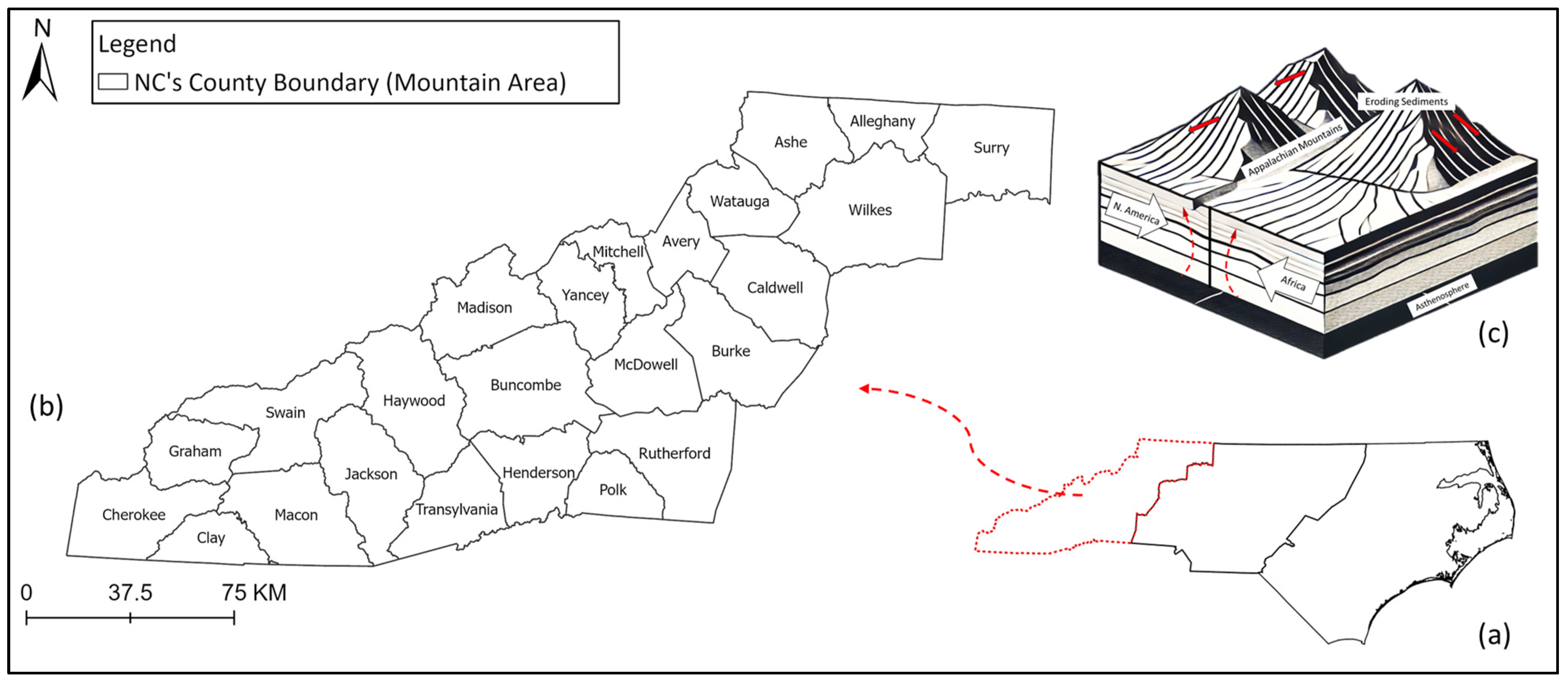
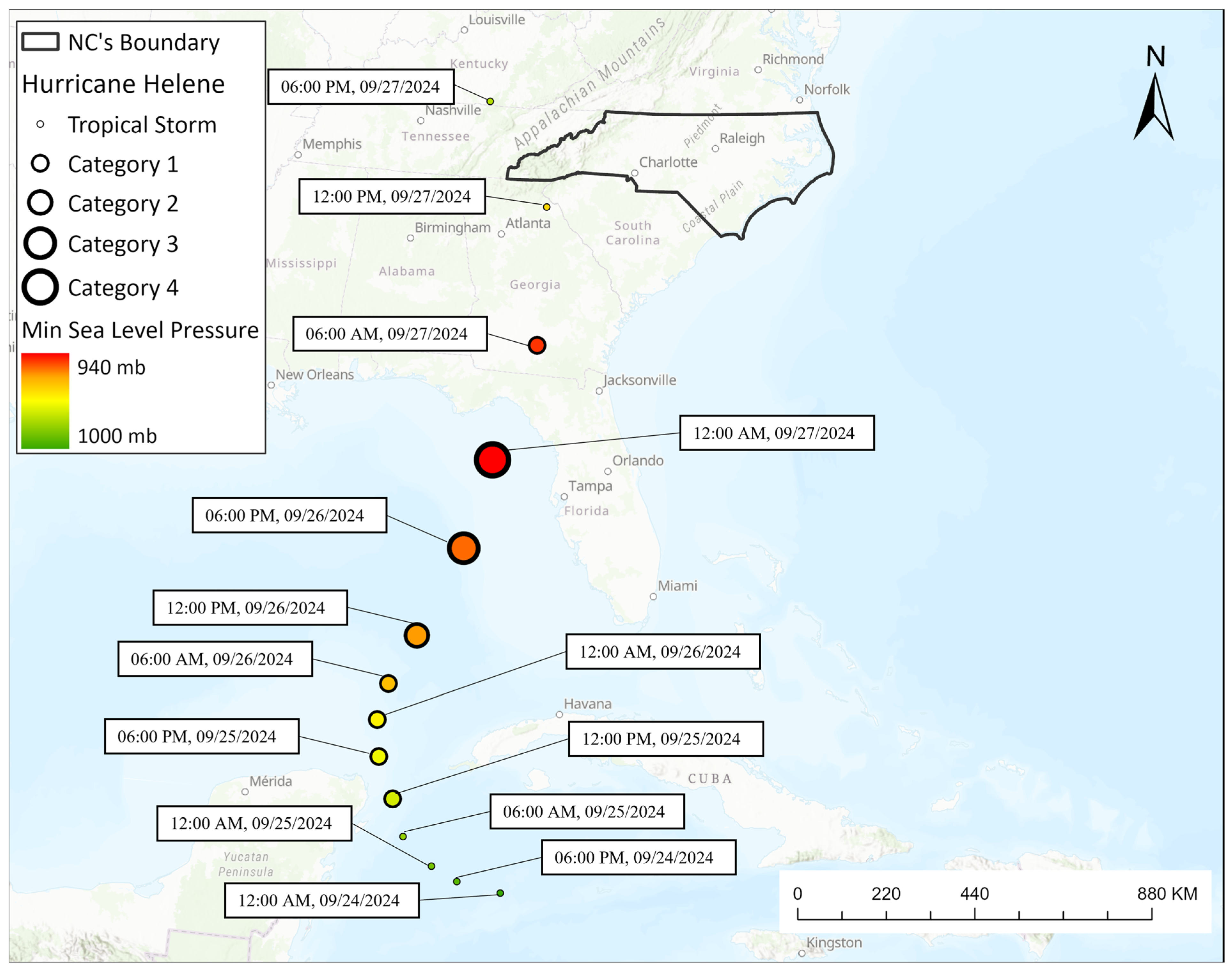
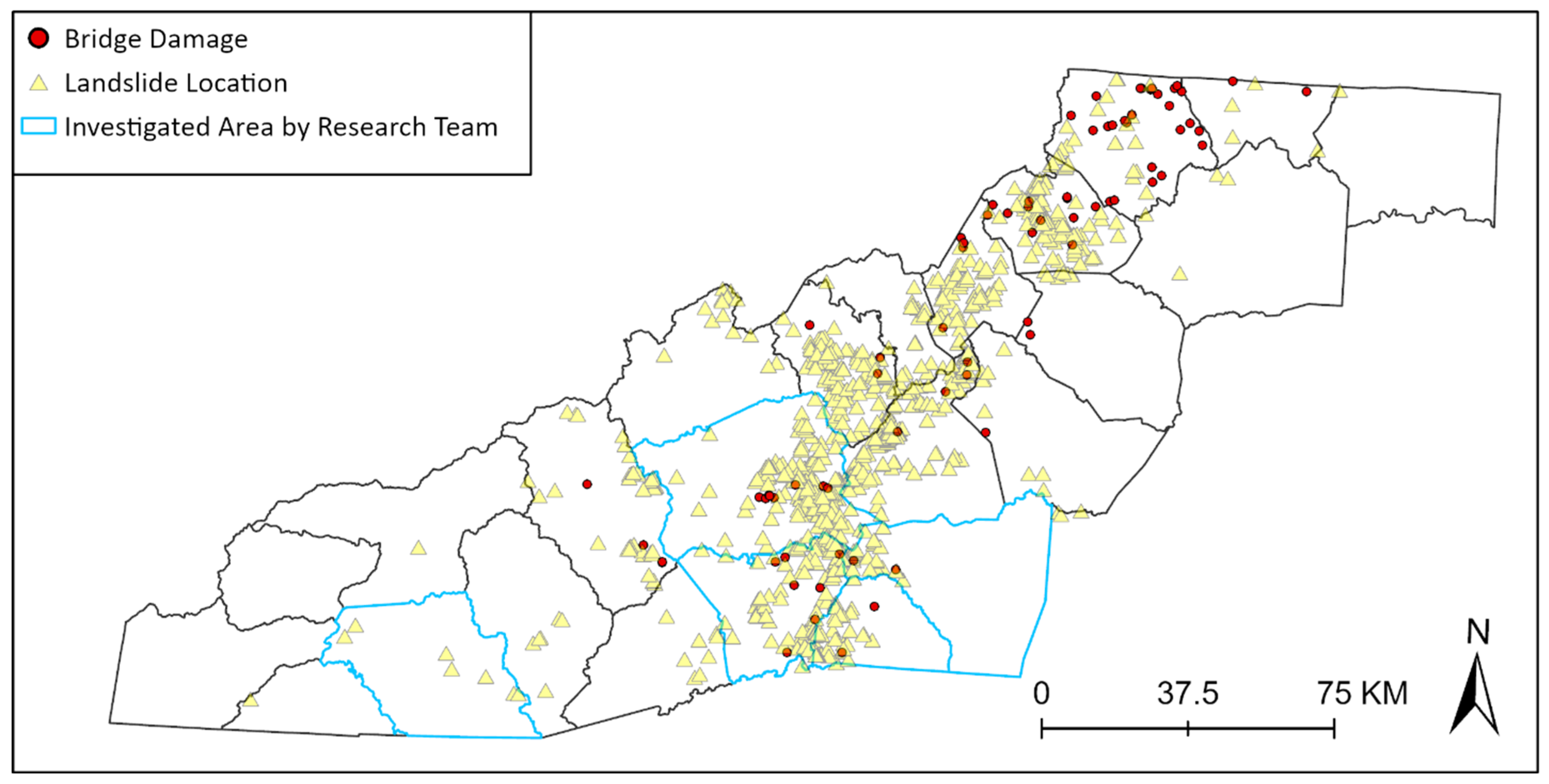
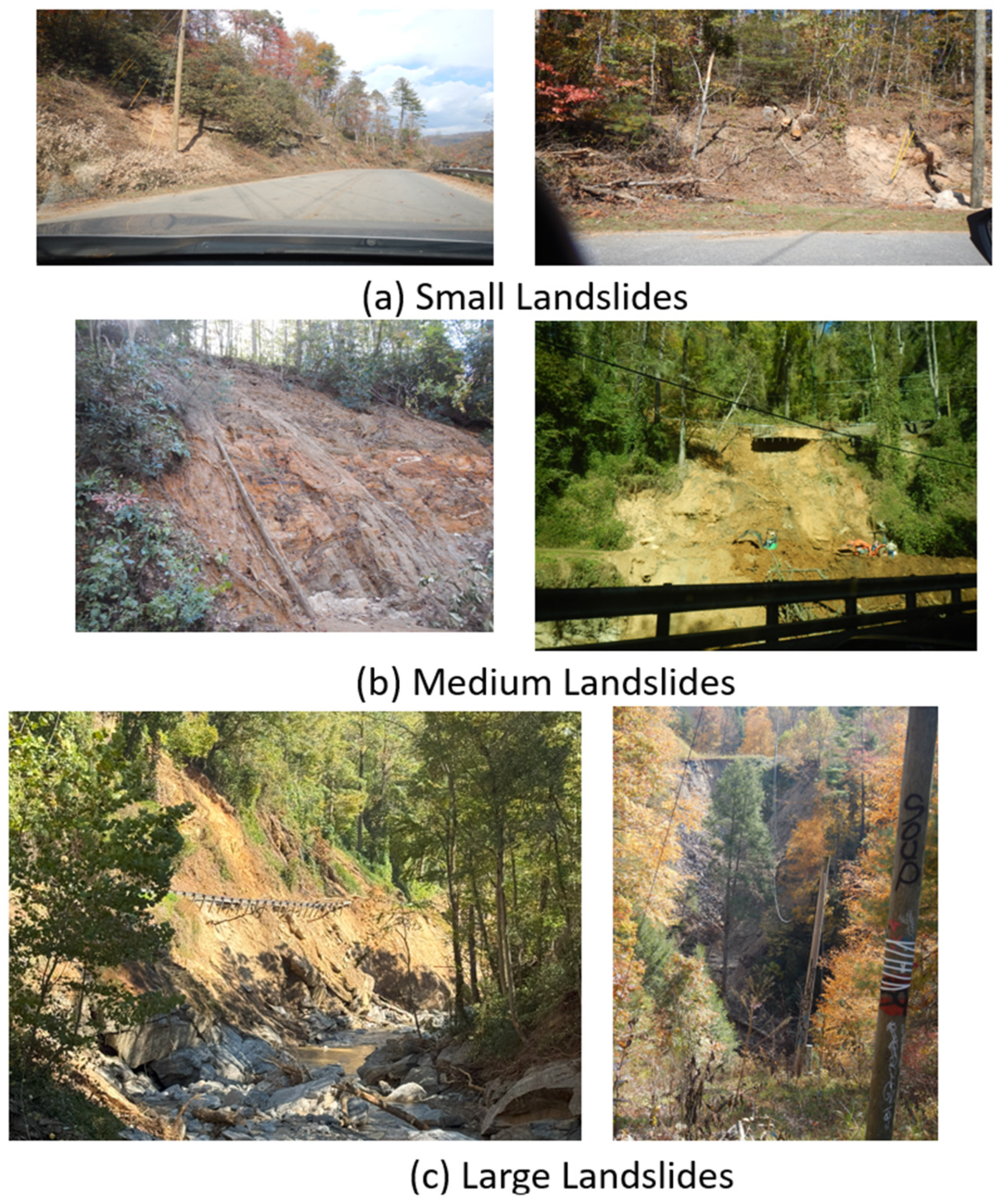

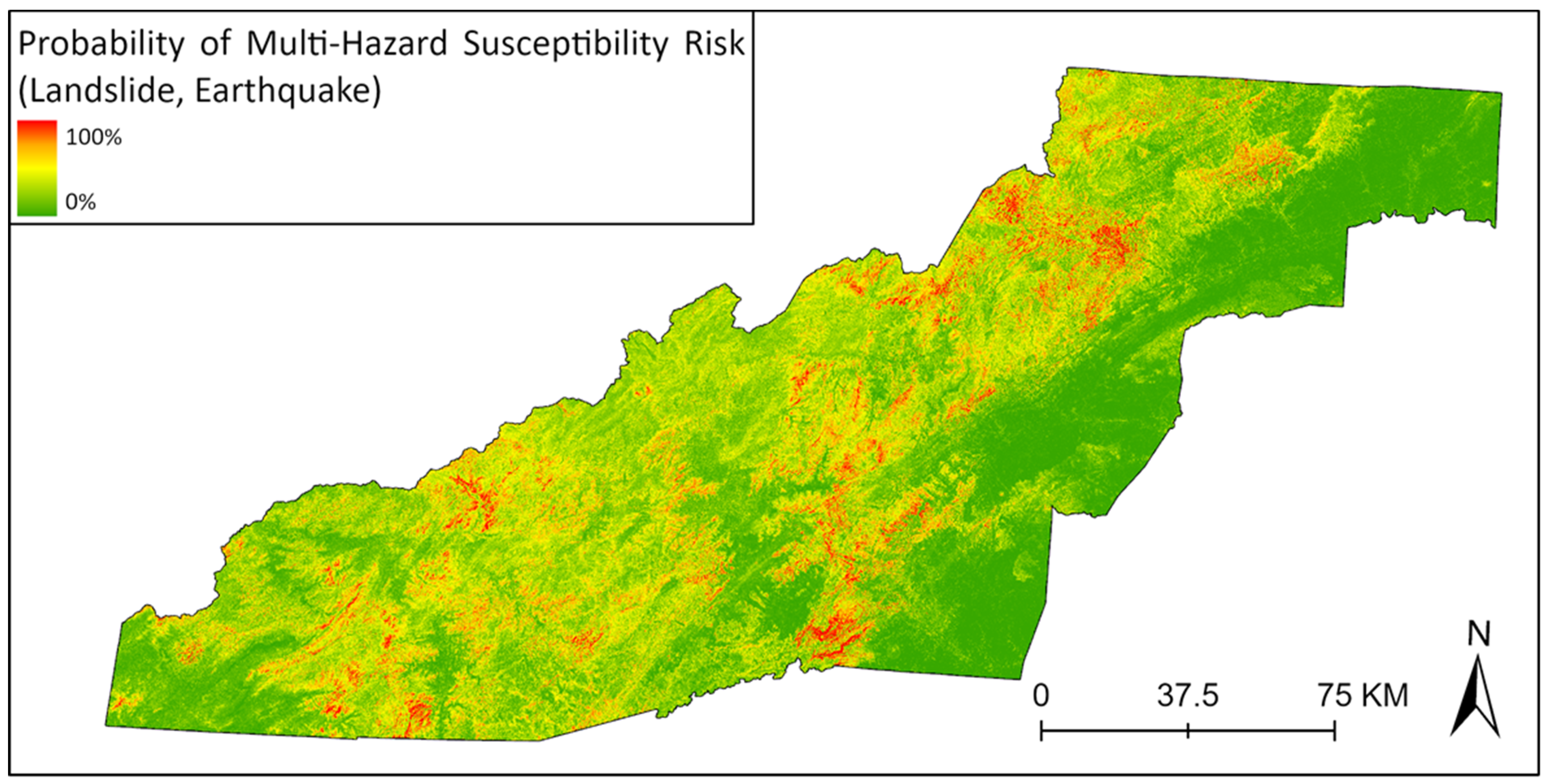





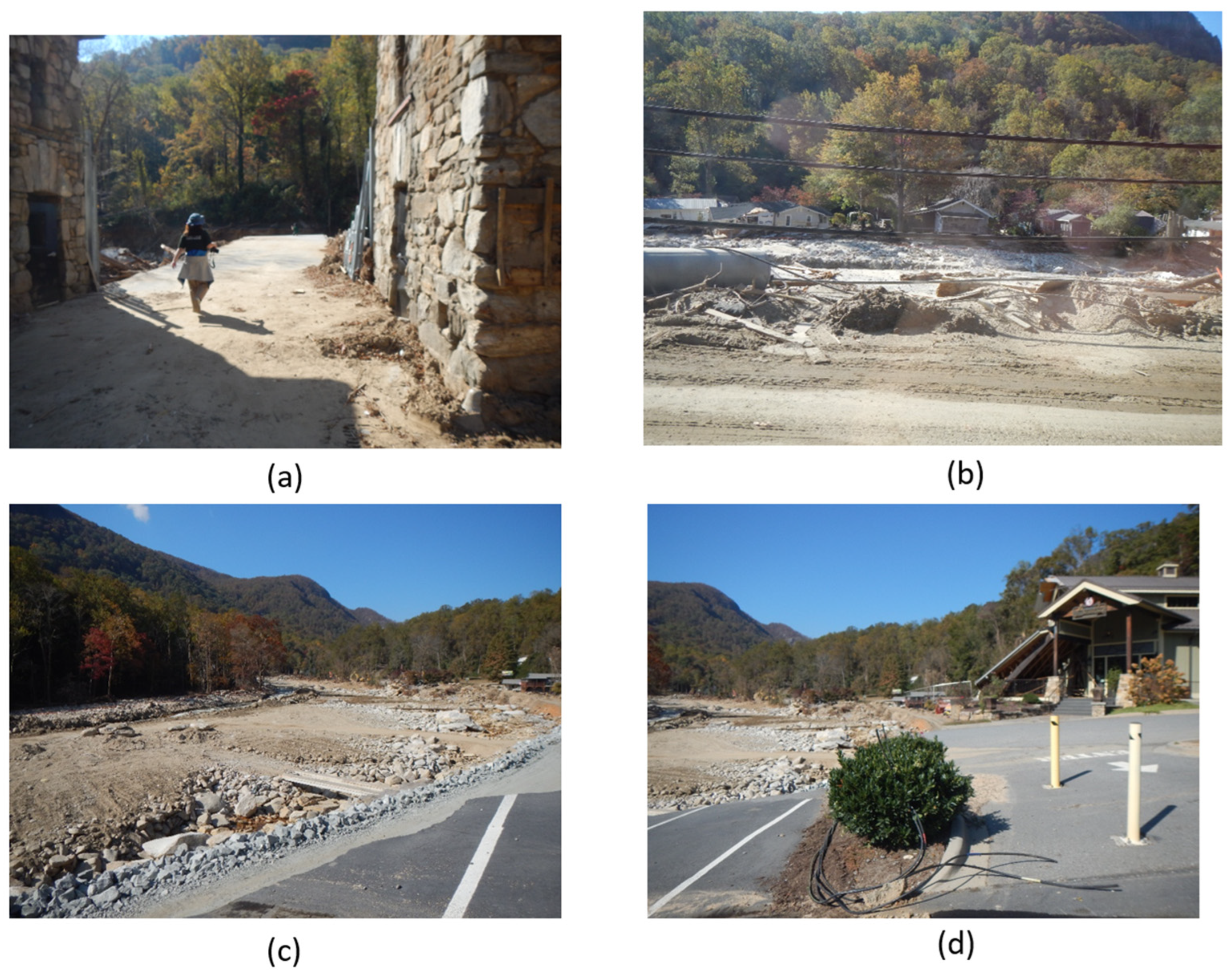
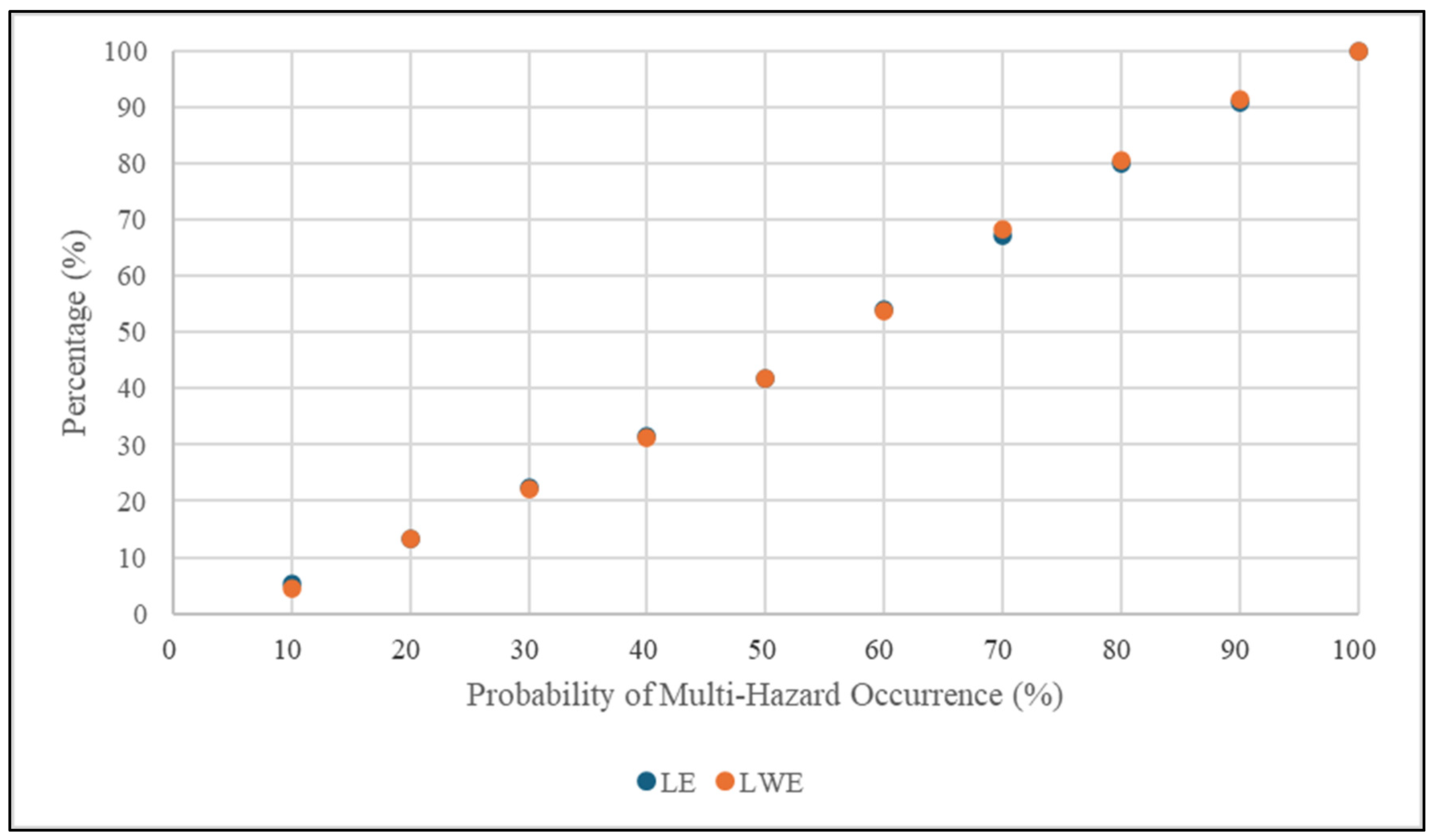
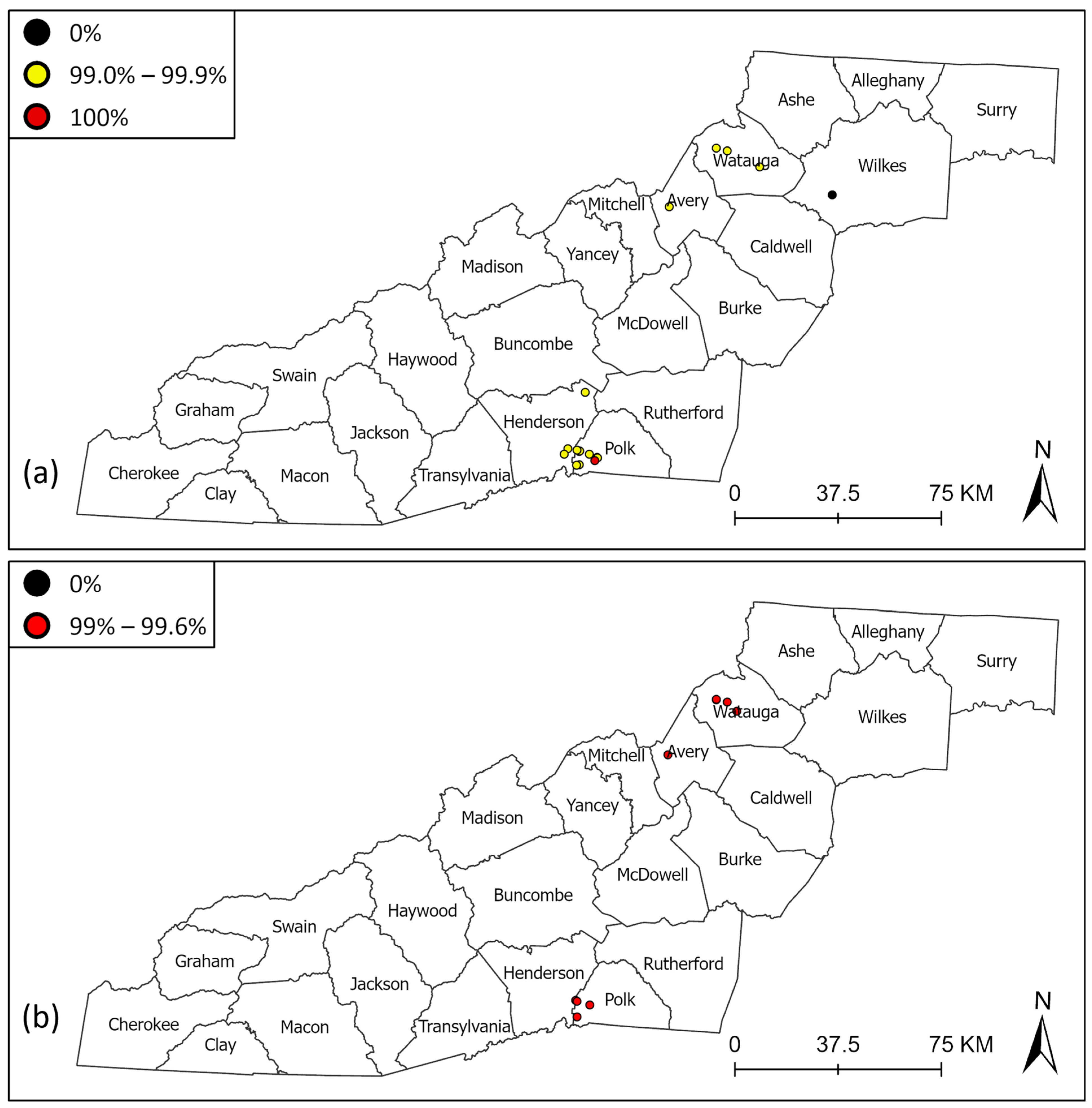

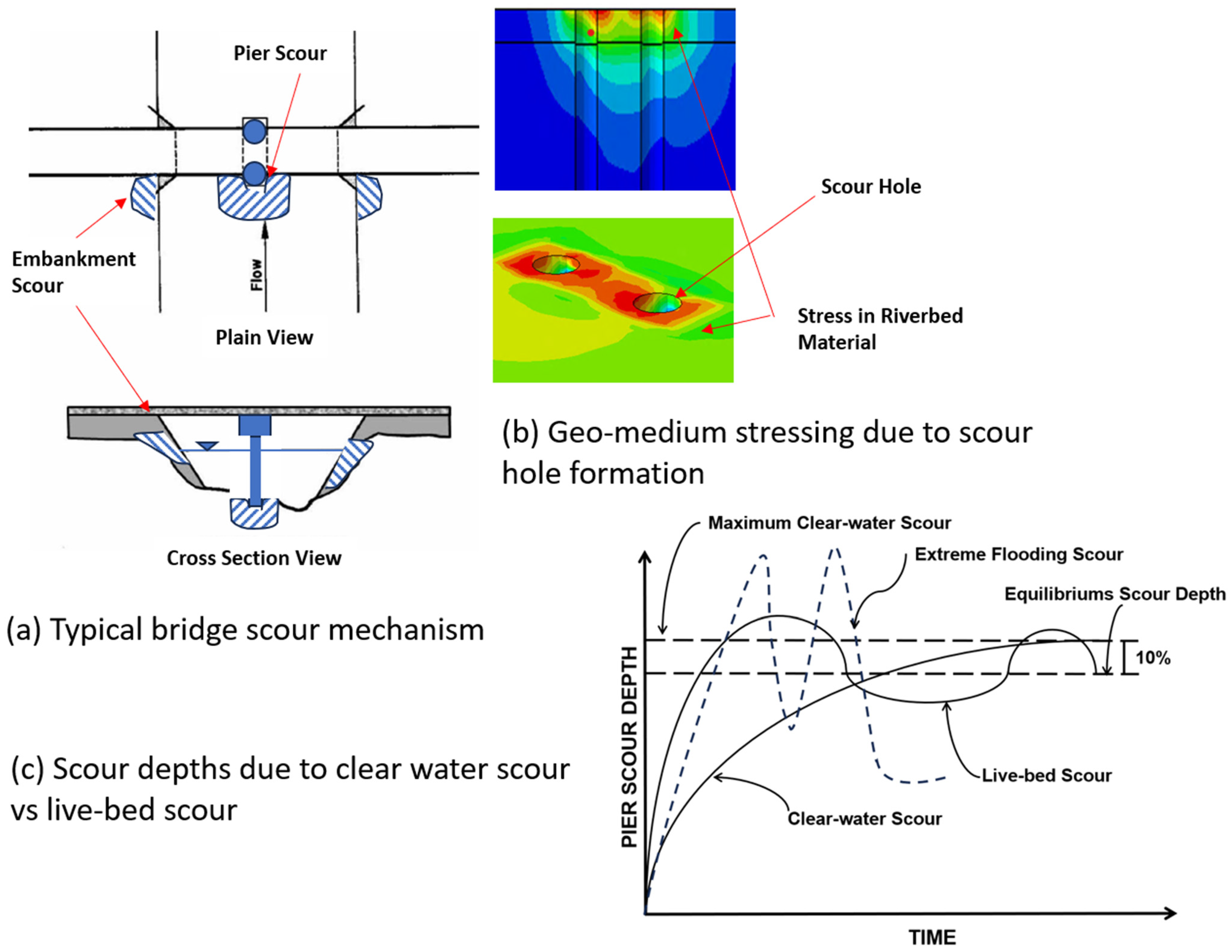
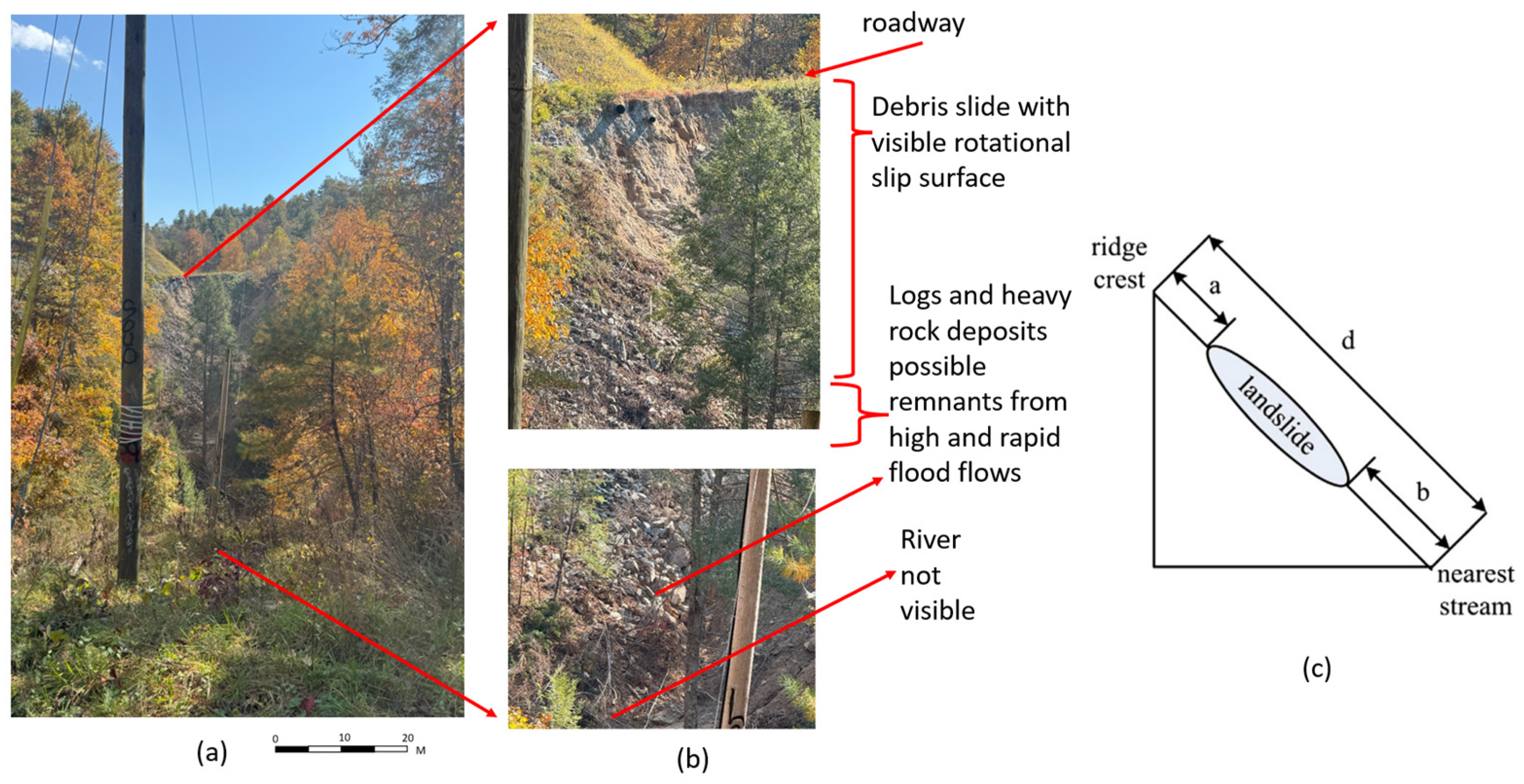

Disclaimer/Publisher’s Note: The statements, opinions and data contained in all publications are solely those of the individual author(s) and contributor(s) and not of MDPI and/or the editor(s). MDPI and/or the editor(s) disclaim responsibility for any injury to people or property resulting from any ideas, methods, instructions or products referred to in the content. |
© 2024 by the authors. Licensee MDPI, Basel, Switzerland. This article is an open access article distributed under the terms and conditions of the Creative Commons Attribution (CC BY) license (https://creativecommons.org/licenses/by/4.0/).
Share and Cite
Lin, S.; Chen, S.; Rasanen, R.A.; Zhao, Q.; Chavan, V.; Tang, W.; Shanmugam, N.; Allan, C.; Braxtan, N.; Diemer, J. Landslide Prediction Validation in Western North Carolina After Hurricane Helene. Geotechnics 2024, 4, 1259-1281. https://doi.org/10.3390/geotechnics4040064
Lin S, Chen S, Rasanen RA, Zhao Q, Chavan V, Tang W, Shanmugam N, Allan C, Braxtan N, Diemer J. Landslide Prediction Validation in Western North Carolina After Hurricane Helene. Geotechnics. 2024; 4(4):1259-1281. https://doi.org/10.3390/geotechnics4040064
Chicago/Turabian StyleLin, Sophia, Shenen Chen, Ryan A. Rasanen, Qifan Zhao, Vidya Chavan, Wenwu Tang, Navanit Shanmugam, Craig Allan, Nicole Braxtan, and John Diemer. 2024. "Landslide Prediction Validation in Western North Carolina After Hurricane Helene" Geotechnics 4, no. 4: 1259-1281. https://doi.org/10.3390/geotechnics4040064
APA StyleLin, S., Chen, S., Rasanen, R. A., Zhao, Q., Chavan, V., Tang, W., Shanmugam, N., Allan, C., Braxtan, N., & Diemer, J. (2024). Landslide Prediction Validation in Western North Carolina After Hurricane Helene. Geotechnics, 4(4), 1259-1281. https://doi.org/10.3390/geotechnics4040064





